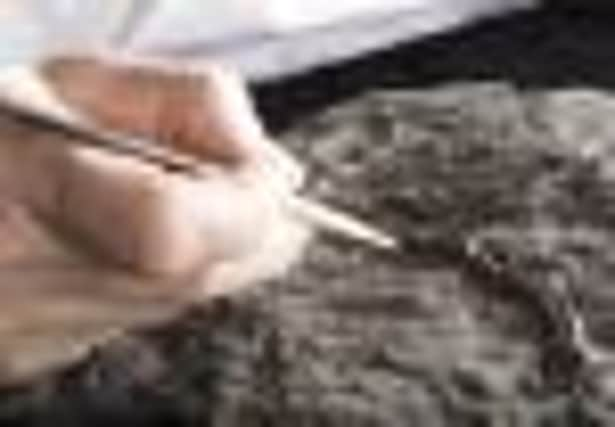Fossil hunters dig deep in Scottish Borders


Scientists will this week start digging up farmland near Berwick-upon-Tweed in a bid to find the “missing link” in the evolutionary process between fish and human beings.
A 500-metre borehole will be drilled in the countryside that the scientists, including those from the Edinburgh-based British Geological Survey (BGS) and the National Museums of Scotland, claim could explain why sea creatures evolved to become land animals, the ancestors of modern animals and human beings.
The exact location of the borehole is not being disclosed.


Advertisement
Hide AdAdvertisement
Hide AdLast year a collection of 20 fossils was found in the area that showed evidence of plants, fish and amphibians during a period between 345 and 360 million years ago where there had previously been little evidence of life.
It is one of only two sites in the world in which the fossils of aquatic tetrapods – fish-like four-limbed vertebrates – have been found.
The scientists now hope that being able to chart the rock and earth in which they were discovered will lead them to understand why these creatures left the water and, over a 15 million-year period known as Romer’s Gap, evolved into animals that lived on land.
“This is a really critical period in history and evolution,” said Dr David Millward, district geologist from the BGS. “Without aquatic tetrapods we wouldn’t have had dinosaurs, birds and ourselves. This is the missing link in the story of evolution and the evolution of life on Earth. It’s the one remaining gap we don’t understand a great deal about. What was the driving force for these things coming out of the water? That’s what we hope to find out.”
Material from the borehole will provide scientists on the TW:eed project (Tetrapod World: early evolution and diversification) with details of the entire rock record in which these new fossils have been found. The core will act as a timeline on which to pin the fossil finds and unearth the evolutionary relationships among early tetrapods to find out how they developed into modern forms.
“Drilling the hole will provide us with a timeframe,” said Millward. “We will be drilling the entire sequence of rocks through that period of time in order to actually set that timeframe and then we can pin all our fossil finds on them, and we will then know which of these animals came first, which came afterwards, and what the relationship is between them.”
The £316,000 TW:eed project involves scientists from the universities of Cambridge, Southampton and Leicester, the National Museums of Scotland and the BGS and is funded by the Natural Environment Research Council. The drilling is being undertaken by Drilcorp.
Professor Jenny Clack of the University of Cambridge, who is leading the project, said: “Our finds will give us real clues as to how the aquatic and fish-like tetrapods evolved into land-going tetrapods.
Advertisement
Hide AdAdvertisement
Hide Ad“Until now, this period in evolution was almost entirely unknown, so that how and when tetrapods acquired limbs and joints that could bear weight and move freely, and jaws that were adapted for feeding on land rather than in water, remained a mystery.”
Millward added that it has long perplexed scientists and geologists as to why aquatic tetrapods chose to leave the water at all when their bodies were not designed for it.
“They were having to change their complete way of life,” he said. “They were aquatic, they had gills, they were built for buoyancy and not for locomotion, and living on land would have involved the consumption of different food materials. Why do it at all?”
The fossils in the Borders were described as “profoundly important” when they were discovered last year as the collection of 20 fossils shows that amphibians, plants and fish all existed during the Romer’s Gap period.
The fossils were unearthed by palaeontologist Stan Wood following a 20-year search. The only other place in the world where similar fossils have been discovered are at Horton Bluff in Nova Scotia, Canada.
Nick Fraser, keeper of natural sciences at National Museums Scotland, described the find as “a real ‘eureka’ moment in palaeontology”.
He said: “These fossils aren’t much to look at in and of themselves, but they may prove to be profoundly important in advancing our understanding of the earliest development of land-dwelling life as we know it today.”
Sir David Attenborough described the fossils as “wonderful”. It is hoped that the drilling project may also uncover more, similar fossils.
Advertisement
Hide AdAdvertisement
Hide AdJust six months after his discovery, Wood, from Selkirk, who found what may be the world’s earliest reptile in a limestone quarry in West Lothian in 1984, died of cancer at the age of 72.
Twitter: @emmacowing